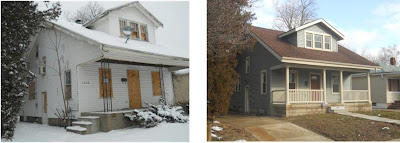If you are a ‘home handyman’ and try to make repairs yourself, here’s a tip. Ruptured water pipes, especially copper, can be easily repaired. Sometimes, however, trying to sweat new piping in place becomes frustrating due to water in the remaining section of the pipe. Heating the pipe with a torch only expands the water and prevents the temperature from reaching a high enough level to melt the solder. Try rolling up a piece of bread and stuffing it into the pipe. It will prevent the water from reaching the solder area and when the job is finished simply turn the water on. The dough will disintegrate and be flushed out of the pipe. Job complete!
South Bend Heritage Foundation Construction Blog
Thursday, February 16, 2012
Monday, January 30, 2012
Environmentally Friendly: Renovation vs. New Construction
Renovating your existing house to make it 30% more efficient will essentially always remain a better bet for the environment than a new house built with the same improved efficiencies. The extensive materials, energy, shipping, and waste required for new construction have an environmental cost that will take longer to overcome than those associated with retrofitting an existing structure. At South Bend Heritage Foundation we are working harder than ever to increase the energy performance of the houses we renovate. The 1920’s bungalow pictured above received hi-efficiency furnace and hot water heater, low-E windows, blown cellulose insulation in all the wall cavities, and 2” of rigid foam over the entire roof deck.
So when thinking about your next housing adventure consider renovation instead of new construction.
Making a Lifetime Investment
Nipsco is currently offering an incentive program to switch old, inefficient furnaces and water heaters to new, high efficiency units. This is a great deal to save you significant money on upgraded units as well as saving $$$ on future energy bills. If you’re thinking about an upgrade, check it out and see if you can qualify by calling 608-729-6826.
Saturday, January 14, 2012
What Does Your Roof Look Like?
It is sometimes difficult to know where your heating/cooling energy dollars are going without using an infrared camera. However, in the winter you can sometimes see signs of heat loss by simple observation. After a snow event, look at your roof compared to surrounding roofs. If your snow seems to melt faster that your neighbors it’s a good indication you need more attic insulation.
$$$ for thought….
Friday, December 30, 2011
Welcome!
Thank you for visiting South Bend Heritage Foundation's Construction Blog. Our focus on providing quality, affordable housing over the past 37 years has given us a unique perspective and a wealth of knowledge in the residential and commercial construction industry.
Our staff Architect, Pat Lynch and Construction Project Manager, Brad Dixon are bursting at the seams to share their A-Z knowledge of the construction industry.
Ever wonder about those Do-it-Yourself (DIY) projects that seem so easy but usually end up looking like a mess that "Holmes on Homes" has to fix? Keep reading our blog and you will be infinitely smarter about residential and commercial construction then you ever thought you could be! Happy New Year from our House to Yours!
Our staff Architect, Pat Lynch and Construction Project Manager, Brad Dixon are bursting at the seams to share their A-Z knowledge of the construction industry.
Ever wonder about those Do-it-Yourself (DIY) projects that seem so easy but usually end up looking like a mess that "Holmes on Homes" has to fix? Keep reading our blog and you will be infinitely smarter about residential and commercial construction then you ever thought you could be! Happy New Year from our House to Yours!
My Home & the 'Mean Season' of Winter
My home and the ‘mean season’, winter.
One of the most important things I do every year to prepare for the frigid temperatures of winter has much less to do with construction and more to do with knowing the environment. Mice, bugs, spiders, birds, squirrels and even bigger pests such as raccoons can target your home for a cozy winter bungalow. I’m constantly amazed at their persistence and ingenuity in finding weaknesses in the construction of homes and find a way to burro into warm and hidden spaces.
Learn to know the local animal characters and how to protect your home from the invasions they plan every winter season. A few minutes spent walking around your house to install simple measures to prevent their intrusion will pay huge dividends and keep you from trying to evict them after they have taken up residence. The former is much easier than the latter. - Brad Dixon, Construction Project Manager
Subscribe to:
Posts (Atom)




